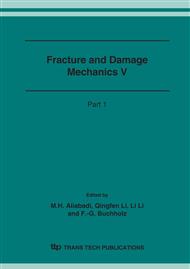p.811
p.815
p.819
p.823
p.827
p.831
p.835
p.839
p.843
Flexural Fatigue Damage Evolution for Partially High Percentage Fiber Reinforced Concrete
Abstract:
Partially High Percentage Fiber Reinforced Concrete (PHPFRC) is a kind of cement composite in which fibers are concentrated with high volume fraction in the tension region of the component under bending. Therefore, PHPFRC possesses much higher load bearing capacity, rigidity, fatigue and fracture properties than conventional steel fiber reinforced concrete (SFRC) while its cost is similar to that of SFRC. In this paper, the fatigue test of PHPFRC is carried out to gain its flexural fatigue damage evolution rule. It is found from the test that, PHPFRC have long post-crack fatigue life and its fatigue damage is tough damage. Based on the continuum damage mechanics and fatigue behavior of the specimens, a fatigue damage variable D for PHPFRC is defined and the elementary form of damage evolution function is determined. For the specimens in which average fiber volume fraction are 1.2% and local fiber volume fraction are 10%, the function parameters and the damage threshold value are given according to the test results.
Info:
Periodical:
Pages:
827-830
Citation:
Online since:
November 2006
Authors:
Price:
Сopyright:
© 2006 Trans Tech Publications Ltd. All Rights Reserved
Share:
Citation:


